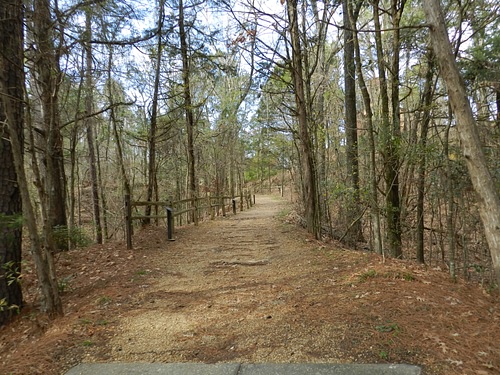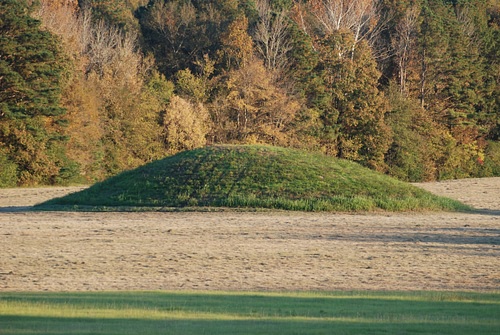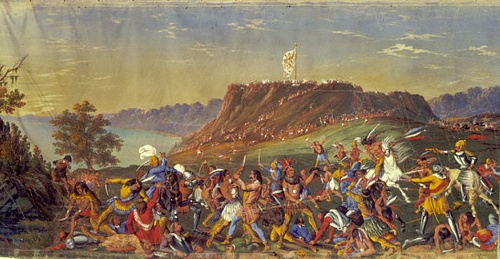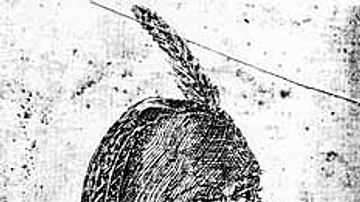
Natchez Trace is a historic site and park in the United States commemorated by the Natchez Trail Parkway stretching 444 miles (715 km) from Natchez, Mississippi, through northern Alabama, to Nashville, Tennessee, roughly adhering to a series of trails first made through the woodlands by prehistoric animals and Native Americans.
The parkway features a number of areas preserving historic sites which closely align with the prehistoric/historic paths, as does the Natchez Trace Trail, a series of hiking trails and footpaths. Both the parkway and the paths take visitors past sites that include former 'stands' (rest stops, inns, and pubs) operated by members of the Chickasaw Nation who owned the land prior to the 19th century CE.
The trace began as large animals, such as bison, made their way through the woods from the south toward the salt licks in modern-day Tennessee. The paths they forged were later followed by Native Americans hunting them, and this then developed into a trade route for the people of the Archaic Period (c. 8000-1000 BCE), the Woodland Period (c. 500 BCE - 1100 CE), and the Mississippian culture (c. 1100-1540 CE). Like the famous Silk Road between Asia and Europe, the trace was never a single path (nor was it known as a 'trace' until the 18th century CE), but a series of trails. After European contact, one of these began to be used by Euro-Americans for trade up through the 19th century, and this was eventually called the Natchez Trace, which continued in use until the popularity of the steamboat diverted trade to the Mississippi River and the trace was neglected.
Interest in the old routes was revived in the early 20th century and the group known as the Daughters of the American Revolution (DAR) spearheaded the effort to restore the best-known path and turn it into a historic site. Restoration and preservation efforts began at this time, evolved into the concept of a parkway linking Natchez, Mississippi and Nashville, Tennessee, and both the parkway was completed in 2005. Although some scholars and historians have pointed out that the parkway does not follow the original trails, the project did succeed in preserving and allowing access to a number of sites that otherwise would probably have been lost.
Early Activity & Formation
Natchez Trace is thought to have been formed thousands of years ago by wild animals moving through the woodlands. Bison are often cited as the prime agents in blazing these trails as they are thought to have traveled from modern-day Mississippi in a general north-easterly direction toward grazing areas and salt licks in Tennessee. The paths they made through the forests were then widened and smoothed by Native American hunting and trading parties.
The path now known as the Natchez Trace Trail was only one of a network of such routes through the woodlands which different Native American communities used in trade with others. By c. 3500 BCE mound sites had already been created as the centers of such communities, and long-distance trade was established prior to c. 1700 BCE as evidenced by artifacts found at Poverty Point, Louisiana. The people of the Poverty Point culture may have used the Natchez Trace, and they may have even helped form the trails, though this is speculation. The trails were already in use by the time of the Adena culture (c. 800 BCE - 1 CE) and the Hopewell culture (c. 100 BCE - 500 CE), both of the Mississippian culture, who developed mound-building and trade along the trails.
Communities & Trade
Long-distance trade routes were initially enlarged and extended by the people of the Hopewell culture who, according to some scholars, were the successors of the Adena. Scholar Ron Fisher comments:
In the eastern part of the continent, by AD 500, people were settling in villages and ruled by chiefs. In today’s Ohio, the people of the Adena culture…built hundreds of mounds, some inside earthen barricades. Their culture included tobacco-smoking rituals, shamans, and long-distance trade… [they were succeeded by] the Hopewell culture, also in Ohio, who built even larger mounds and had even more elaborate burial rituals than the Adena. Objects were often buried with their owners, including figurines that show how the Hopewell people dressed and wore their hair. Their trade routes extended over much of North America. (12-13)
The Hopewell culture also spread their religious beliefs and practices, whether intentionally or simply through contact in trade, and the mounds which are found today along the Natchez Trace are understood as evidence of this. The Hopewell people were prolific mound builders who influenced the mounds produced by those who came after them, such as the ancestors of the Natchez tribe of modern-day Mississippi. The Natchez were agriculturalists, growing corn, beans, and squash (among other crops) as well as hunting, fishing, and gathering their food supplies. They used their surplus in trade and used the Natchez Trace as their primary route as evidenced through artifacts and the mounds still extant along that track today.
Mounds of the Trace & Religion
The early Natchez Native Americans built their central village (known today as Grand Village) in present-day Natchez, Mississippi with the Great Sun’s Mound in the center. This flat-topped mound provided the elevated area for the residence of the chief, known as the Great Sun, and believed to be the brother of the sun, giver of life. The chief’s mound was created here, as at other mound sites, to elevate the chief closer to the sun for clearer communication and communion. Other mounds were built, some by the Natchez and some by others, to the northeast along the trace, such as Emerald Mound (built c. 1250-1600 CE), Pharr Mounds (c. 1-200 CE), Bynum Mounds (c. 100 BCE - 100 CE), Boyd Mound (c. 800-1100 CE), and Bear Creek Mound (c. 1100-1300 CE), among others. These mound sites may be visited today while many others built along the trace have disappeared either through erosion or purposefully eliminated by later settlers.
The mound sites were not all residences of chiefs or burial mounds but also served as sacred ceremonial sites where rituals were performed, either on their tops or in plazas built at their bases. The rituals were informed by the Native American belief in animism – that all things have a soul and are dependent upon each other in a great web of interconnected reciprocity – and at the heart of animism was the concept of spiritual power. Everything was imbued with the energy of the Great Spirit (whatever name a given tribe knew this Being as) who had breathed life into the world. The mounds are thought to have been constructed to harness or focus this energy in a given place for the greater benefit of the people.
As the people gave thanks and participated in rituals at the mound site, they gave energy to the spirit of the place (and, by extension, the Great Spirit) and received energy back in the form of plentiful harvests, abundant game, and nets overflowing with fish. The natives understood that all of nature was alive with spirits and that the land, therefore, needed to be respected as well as everything living in it so as not to anger the Great Spirit through ingratitude, which could cause the loss of all their livelihood.
The natives interacted with the area now known as Natchez Trace just as they did with any other and so, although paths were formed and expanded through the woods, the region remained pristine save for those spots selected for crop cultivation, villages, and mound building. At the time when most of the mounds were being built, of course, European colonization was centuries in the future but the rituals honoring the spirits of a given place were still in practice when the first Europeans first arrived in the region.
European Contact & Colonization
The first Europeans to arrive in the area were the Spanish under the command of the conquistador Hernando de Soto (l. c. 1500-1542) who led a small army up from Florida into the region in 1540 searching for gold. De Soto never found what he was looking for but did succeed in slaughtering a number of natives he accused of hiding the gold from him and killing many others through the spread of European diseases they had no immunity to. De Soto’s expedition recorded the ceremonies still being performed at mounds along the future Natchez Trace as well as other details of the period, including interactions with the Chickasaw Nation who would eventually come to control the trace.
The second wave of Europeans were the French. René-Robert Cavelier, Sieur de La Salle (l. 1643-1687) first claimed the region, which he named Louisiana, for France in 1682 but never established a settlement. Pierre Le Moyne, Sieur d’Iberville (l. 1661-1706) built the first fort in the region in 1699 but this was a garrisoned military site, not a residential settlement. Another fort was built at Natchez in 1716, Fort Rosalie, which – it was hoped – would provide the kind of security and stability to enable a permanent agricultural and commercial settlement. Unfortunately, the French view of the land clashed with that of the indigenous people, causing conflict. Scholar Alan Taylor comments:
An animist perspective discouraged the sort of mechanistic development practiced by Europeans. Lacking domesticated animals and metals tools and weapons, the Indians seemed a primitive people to the Europeans. The natives, however, regarded themselves as more intelligent and resourceful than the Europeans. Animism both derived from and encouraged the distinctive forms of perception and ingenuity demanded by hunting and gathering – practices essential to almost all native peoples, even those who also cultivated domesticated plants. Native peoples keenly observed the diverse forms of edible or healing life in the forest and waters, and they mastered the best times and techniques for finding and harvesting wild plants and animals. Because the Europeans lacked these skills and that knowledge, they struck the Indians as clumsy babes in the woods. From the native perspective, it seemed that the colonizers had exhausted their intelligence in making their metal and cloth goods. Preoccupied with dead matter, they appeared insensitive to living nature. (19-20)
The French, having no knowledge of the concept of a spirit of place, claimed land for Fort Rosalie which was sacred to one segment of the Natchez Nation, who attacked in 1729 and killed almost the entire garrison. The French came back in 1730, led by the Native American Choctaw, and took Grand Village. The French sold around 300 Natchez captives into slavery in the West Indies and the survivors found homes with the Creek and Cherokee nations nearby. With the Natchez tribe nearly eliminated, the Choctaw and Chickasaw established themselves more firmly in the region. The Chickasaw eventually beat out the Choctaw for trade agreements with the French and claimed the woodlands encompassing the trace.
Jefferson, Jackson, & the Chickasaw
After France lost the French and Indian War (1754-1763) to Britain, their lands along the east coast were taken by the English but those inland remained French. Once the English colonies won their independence in 1783, they began expanding further west and, in an effort to establish trade and communication routes with the American frontier, President Thomas Jefferson (served 1801-1809) ordered a path cleared between Tennessee and Mississippi and the soldiers sent to perform this task found one well-used route already opened and simply widened it further in 1801.
After the Louisiana Purchase in 1803, more work was directed toward the route Jefferson named the Columbian Highway and, after negotiation with the Chickasaw, that nation was given exclusive rights to build and operate stands along the road to serve travelers. These stands varied in size, shape, and purpose from small wooden shacks serving food and alcohol to inns to restaurants/pubs and trading posts. Whatever function they served or shape they took, the Chickasaw establishments came to be known as stands.
These stands encouraged more travelers to use the Natchez Trace as it was no longer a wilderness, and the Chickasaw maintained their own peace with the government of the United States as well as agreements made by other tribes in the area. The Natchez Trace was still well known for highwaymen, cutthroats, and confidence men, but if one could evade these, there were places along the way to find a meal, some semblance of safety, and a bed for the night. The treaty with the Chickasaw also allowed for the establishment of the Chickasaw Agency (1802-1825) which was an arm of the United States government tasked with keeping the peace along the trail. Agents were responsible for apprehending criminals and fugitives, retrieving stolen property, maintaining friendly relations with the natives, and assisting in the operation of the stands.

General Andrew Jackson (l. 1767-1845, later president 1829-1837) used part of the trace during the War of 1812, guided by his allies the Chickasaw, to move troops from Tennessee down to Louisiana to fight the British and so attracted national attention to the route. The main demographic responsible for making the trace famous, however, was the people who came to be known as Kaintucks. These were merchants originally from Kentucky (hence the name) but eventually 'Kaintucks' came to be applied to anyone coming by a flat boat down the Mississippi to trade. They would exchange their goods at the landing Natchez Under-the-Hill, and then, because there was no way to get their boats back upriver against the current, they would sell the craft and walk or ride up the Natchez Trace to Nashville. The Kaintucks were primarily responsible for putting Natchez Trace on the map and giving it the place in history, which led to its preservation in the 20th century.
Conclusion
Although the Chickasaw had maintained the peace in good faith and had even fought alongside Jackson in the War of 1812, they were cheated out of their land and forced west by Jackson’s Indian Removal Act of 1830. The Chickasaw were the last Native American tribe to leave on the Trail of Tears to the west in 1837. The stands formerly operated by Chickasaw were now taken over by white Euro-Americans and land was cleared further for the kind of settlements the French had hoped to establish over 100 years earlier.
Settlements encouraged further commerce and the trace continued in use until river travel became cheaper and easier. Although the steam engine had been invented in 1698, the steamboat was not successfully realized until 1807, and the first to travel the Mississippi was the New Orleans in 1811. As steamboats became more popular and accessible, the Natchez Trace was abandoned as a trade route until, by c. 1880, it had been almost forgotten.
In 1890, the organization known as the Daughters of the American Revolution was formed to promote civic sentiment and national pride in Americans by reminding them of their past, especially events touching on the American Revolution and figures such as the Founding Fathers. In 1906, one Elizabeth Jones (l. 1868-1949), then-president of the DAR chapter in Mississippi, spearheaded the initiative to preserve Natchez Trace with "monuments and markers to inspire a sense of national pride and patriotism" (Elliot Jr., 2). Scholar Jack D. Elliot Jr. notes "the campaign for better roads that was sweeping America took full advantage of the increased interest in heritage and history," and Jones’ campaign received significant support (2). By the 1930s, the DAR had already placed monuments at the trace which inspired developers to further push the history-and-heritage agenda in making Natchez Trace a highway. In order to preserve as much of the natural environment as possible, however, this plan was scrapped in favor of a parkway, which would not allow commercial traffic or development along the route.
The original path known as the Natchez Trace was unsuitable for this project, however, as it wound too widely and so an “approximate path” was surveyed which would allow travelers access to many of the sites once along the trace while hiking trails and paths would grant access to others. Construction of the parkway began in 1938, but, because of the difficulty in linking various sites, progress slowed – and often stopped – and the commemorative parkway was not completed until 2005.
In the present day, it is among the most popular routes of the region and a national tourist attraction allowing travel along a scenic route, with multiple pull-offs at historic spots, from Natchez, Mississippi, to Nashville, Tennessee. Among the many sites one can stop at are the mounds and historic markers memorializing long-gone Chickasaw stands, significant events and people (such as the grave of the explorer Meriwether Lewis of the famous Lewis & Clark expedition), and the ruins of once-grand structures like the Windsor Estate, burned to the ground in 1809 by a carelessly thrown cigarette or cigar. Even though one must acknowledge that the parkway does not follow the original trace, it preserves the history of the old trade route and keeps alive the memory of all those who once used it going back to the first people who followed the animal trails through the wilderness.








